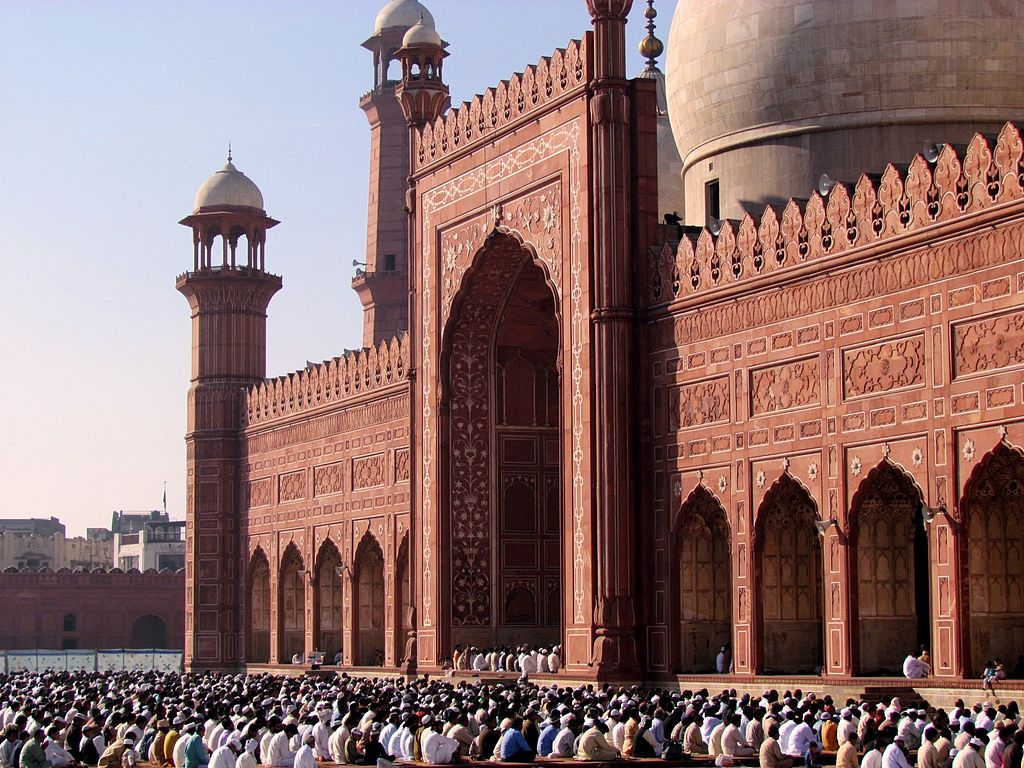The Badshahi Mosque, a jewel of Mughal architecture, graces the cityscape of Lahore, Pakistan, with its majestic presence. Commissioned by the sixth Mughal Emperor, Aurangzeb, the mosque stands as a testament to the grandeur and opulence of the Mughal era. Situated adjacent to the Lahore Fort, the Badshahi Mosque has become an iconic symbol of the city’s rich cultural heritage and religious tolerance.
Construction of the Badshahi Mosque began in 1671 and was completed in 1673 during the reign of Aurangzeb. The mosque was envisioned as a symbol of the Mughal Empire’s might and the spiritual prowess of its rulers. Designed by the renowned architect Nawab Zain Yar Jang Bahadur, the mosque’s architectural style is a fusion of Persian, Central Asian, and Indian influences, resulting in a harmonious blend of form and function.
The Badshahi Mosque’s imposing exterior is marked by red sandstone and white marble, creating a visually stunning contrast. The grand entrance is adorned with intricate calligraphy and geometric designs, reflecting the Mughal appreciation for fine craftsmanship. The mosque’s massive courtyard, capable of accommodating thousands of worshippers, provides a sense of the monumental scale of the structure.
At the heart of the Badshahi Mosque is its main prayer hall, a vast chamber adorned with intricate stucco tracery, frescoes, and marble inlay. The interior showcases the Mughal commitment to aesthetic excellence and attention to detail. The prayer hall is crowned by three imposing marble domes, each adorned with a lotus-shaped finial, creating an awe-inspiring sight against the Lahore skyline.
One of the most distinctive features of the Badshahi Mosque is its four towering minarets. Standing at a height of 176 feet, these minarets provide a commanding presence and are visible from afar. The minarets are embellished with vertical stripes and delicate balconies, adding to the mosque’s overall architectural elegance.
The Badshahi Mosque is also home to the Alamgiri Gate, the main entrance that faces the Hazuri Bagh and the Lahore Fort. The gate is a masterpiece of Mughal artistry, featuring intricate carvings, calligraphy, and an imposing central arch. The grandeur of the Alamgiri Gate serves as a fitting prelude to the magnificence that lies within the mosque complex.
A notable aspect of the Badshahi Mosque is its symmetrical design, embodying the Mughal commitment to balance and proportion in architecture. The meticulous planning and execution of the mosque’s construction highlight the engineering expertise of the Mughal architects, ensuring both aesthetic beauty and structural stability.
The Badshahi Mosque has witnessed various historical events, including the Sikh occupation of Lahore in the early 19th century and its subsequent use as a military garrison. Despite periods of neglect and deterioration, the mosque has undergone extensive restoration efforts to preserve its architectural splendor and cultural significance.
Today, the Badshahi Mosque stands not only as a place of worship but also as a symbol of Lahore’s identity and resilience. It attracts visitors from around the world who marvel at its architectural magnificence and immerse themselves in the historical legacy it represents. The mosque remains an active center for religious and cultural activities, hosting congregational prayers, religious events, and serving as a backdrop for various celebrations.
In conclusion, the Badshahi Mosque is a living testament to the grandeur of the Mughal era and the enduring spirit of Lahore. Its architectural brilliance, cultural significance, and historical resilience make it an integral part of Pakistan’s heritage. As a symbol of religious tolerance and aesthetic excellence, the Badshahi Mosque continues to stand as a testament to the artistic and spiritual legacy of the Mughal Empire.



